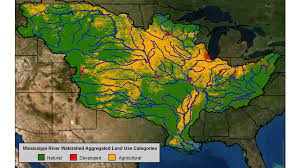
by Bill Schlesinger
I found a glimmer of good news last month amongst the scientific literature that I follow regularly. Jien Zhang and his colleagues at Iowa State University use a large database to find that the nutrient-use efficiency of some key agricultural crops (corn, rice, cotton and sorghum) in the Mississippi Basin has increased from an average of 0.55 kg of nitrogen taken up per kg of N applied as fertilizer during the 1970s to 0.65 kgN/kgN during the last decade. That indicates that through crop breeding and better agricultural practices, including more judicious use of fertilizer, a greater percentage of the nitrogen in fertilizer is actually getting into the crop and less remains in the environment. Greater adoption of no-till agriculture and cover crops may be helping. Other good news stems from a recent report by Guntur Subbarao et al. (2021) who inserted a gene into wheat that inhibits the transformation of nitrogen from ammonia to nitrate in the soils, which should help reduce losses of nitrogen in runoff.
The Mississippi provides an iconic study of nitrogen transport, which leads to hypoxia in the Gulf of Mexico. One might expect that a trend of increasing nitrogen-use-efficiency might show up in declining levels of soluble nitrogen in the River itself. Unfortunately, that is not the case. Waste nitrogen still amounts to 41% of what is applied, so there is much further work to do. At best there is no recent trend for the nitrogen concentrations in the Mississippi, and the values remain much higher than 50 years ago. Why?
The legacy of nitrogen fertilizer use means that changes in the nitrogen chemistry in the Mississippi will lag behind improvements in nitrogen use in its watershed. A lot of nitrogen applied in agriculture is retained in the soils, the drainage-tile network in agricultural fields, and in sediments along the way. It will take a long time to flush this past memory of nitrogen use out of the ecosystem.
Still, the problem begins in the farm field, so this report of increasing nitrogen-use-efficiency is a welcome first step to solving a huge problem.
References:
Byrnes, D. K., Van Meter, K. J., & Basu, N. B. (2020). Long‐term shifts in U.S. nitrogen sources and sinks revealed by the new TREND‐nitrogen data set (1930–2017). Global Biogeochemical Cycles, 34, e2020GB006626. https://doi.org/10.1029/
Gardiner, J.B. and L.E. Drinkwater. 2009. The fate of nitrogen in grain cropping systems: a meta-analysis of 15N field experiments. Ecological Applications 19: 2167-2184.
Kreiling, R.M. and J.N. Houser. 2016. Long-term decreases in phosphorus and suspended solids, but not nitrogen, in six upper Mississippi River tributaries, 1991-2014. Environmental Monitoring and Assessment 188: doi 10.1007/s10661-016-5464-3
Norton, R., Davidson, E., & Roberts, T. (2015). Nitrogen use efficiency and nutrient performance indicators. Global Partnership on Nutrient Management.
Subbarao, G.V. and 13 others. 2021. Enlisting wild grass genes to combat nitrification in wheat farming: a nature-based solution. Proceedings of the National Academy of Sciences doi: 10.1073/pnas.21065951118
Sebilo, M., et al. 2013. Long-term fate of nitrate fertilizer in agricultural soils. Proceedings of the National Academy of Sciences 110: 18185-18189.
Stackpoole, S., R. Sabo, J. Falcone and L.A. Sprague. 2021. Long-term Mississippi River trends expose shifts in the river load response to watershed nutrient balances between 1975 and 2017. Water Resources Research doi 10.1029/2021WR030318
Tian, H., et al. 2020. Long-term trajectory of nitrogen loading and delivery from Mississippi River basin to the Gulf of Mexico. Global Biogeochemical Cycles doi: 10.1029/2019GB006475
Zhang, J., P. Cao and C. Lu. 2021. Half-century of crop nitrogen budget in the conterminous United States: variations over time, space and crop types. Global Biogeochemical Cycles doi: 10.1029/2020GB006876
See also: Nitrogen in Runoff – Translational Ecology (duke.edu)